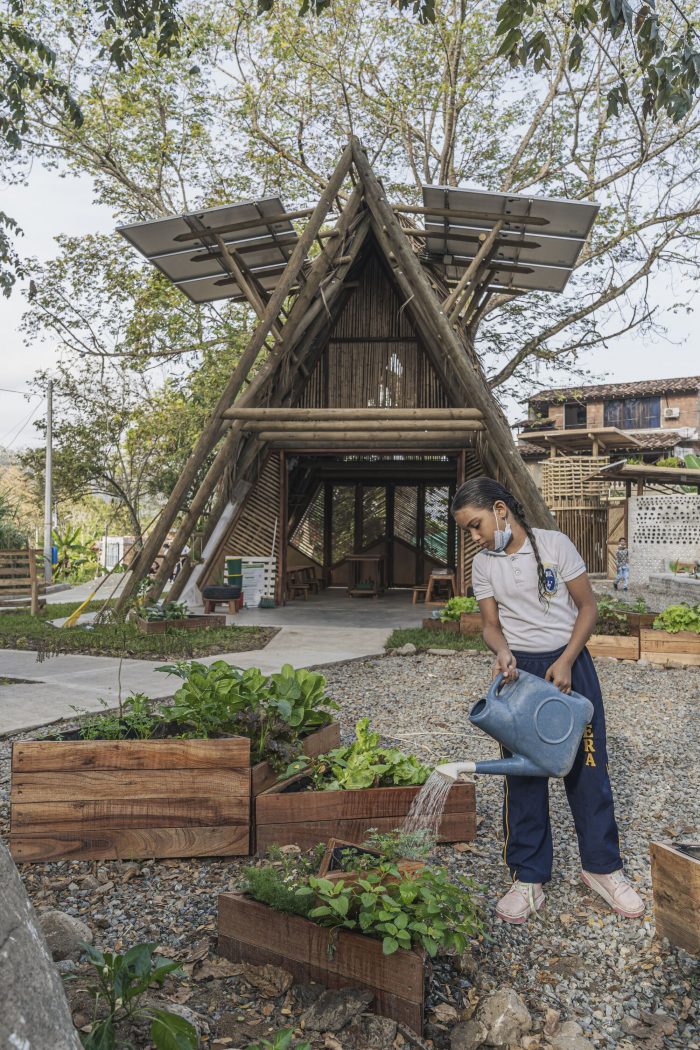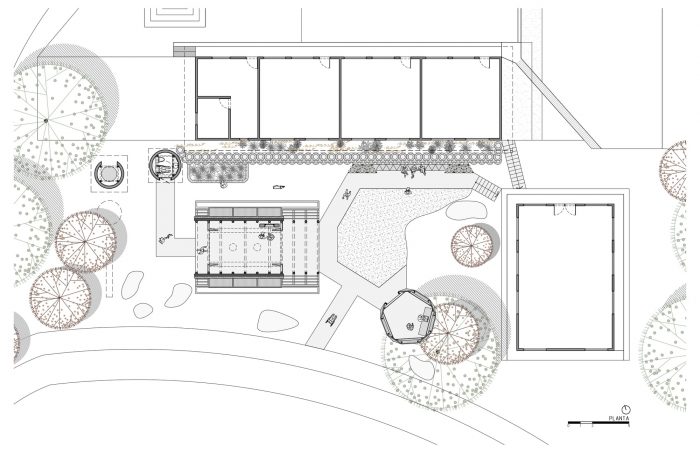这个项目是由TAGMA民间协会委托进行的,该协会致力于在拉丁美洲发展教育性、参与性和可持续性项目。他们在不同国家建立了一个由九个环境教室组成的网络。阿根廷、乌拉圭、智利、秘鲁、哥伦比亚等。为了开展这些小规模的教育建筑,他们在各地区寻找盟友:市政当局、公共教育机构、私营公司、社区和当地建筑师团队。在一个参与性的设计过程之后,他们将施工阶段作为一个教育活动来进行,建筑和施工学生以及各种参与者在一个国际教师团队的指导下前往现场;最后,他们陪同并建议未来的学术活动。
This project was commissioned by the TAGMA Civil Association, dedicated to developing educational, participatory, and sustainable projects in Latin America. They have built a network of nine environmental classrooms in various countries: Argentina, Uruguay, Chile, Peru, Colombia, etc. To carry out these small-format educational buildings, they seek allies in the regions: municipalities, public educational institutions, private companies, communities, and teams of local architects. After a participatory design process, they carry out the construction phase as an educational event with architecture and construction students and various participants guided by an international team of teachers who travel to the site; finally, they accompany and advise future academic activities.
在哥伦比亚的 “环境教室 “项目中,我们的办公室从最初阶段就参与了选择建造该项目的教育机构的工作。要干预的地方是位于安蒂奥基亚省圣赫罗尼莫市的埃尔林孔教育机构,距麦德林一小时车程。现有的学校有两座平行的长条形建筑,由一个院子连接。我们建议新的建筑继续采用这种平行条形的城市方案,用天井和花园分隔。可用的区域与附近的社区相连,并被当地的树木所包围。该项目包括用于上课、培训和会议的灵活空间;一个室外浴室;一个从邻近建筑屋顶收集雨水的水箱;一个用于会议的亭子–由Tagma设计和建造–;果园;以及景观设计。对于教室,我们建议采用免疫木的三角形结构,耐腐蚀,低维护;粘土砖、木头和瓜豆的覆层;捐赠的钢化玻璃外墙;以及厚厚的棕榈树屋顶。该建筑具有交叉通风和南北朝向,支持六个串联的太阳能电池板,产生足够的能量供其运行。
In the case of the Environmental Classroom in Colombia, our office participated from the initial stage for the election of the educational institution chosen to build the project. The place to intervene was the El Rincón Educational Institution in the municipality of San Jerónimo, Antioquia, one hour from Medellín. The existing school had two long, parallel buildings linked by a courtyard. We proposed that the new construction continue this urban scheme of parallel bars, separated by patios and gardens. The available area was connected to a nearby neighborhood and was surrounded by native trees. The project consists of flexible space for classes, training, and meetings; an outdoor bathroom; a tank that collects rainwater from the roof of the neighboring building; a kiosk for sessions -designed and built by Tagma-; orchards; and landscaping. For the classroom, we proposed a structure with a triangular section of immunized wood, resistant and low maintenance; cladding in clay bricks, wood, and guadua; facades in donated tempered glass; and a thick palm roof. This construction, which has cross ventilation and a south-north orientation, supports six solar panels connected in series, which generate enough energy for its operation.
浴室和水箱–用土砖、回收的瓶子、木材、Guadua和金属瓦建造–作为一个自主的水系统,废水进入生物消化器,然后进入植物细胞。上述系统由菜园、堆肥箱、昆虫旅馆和仔细的废物处理来补充。这个小建筑的计划是理论和实践的环境教育。出于这个原因,它的多种可持续发展战略是明确的、可见的,并且是教育经验的一部分。
The bathroom and the tank -built with earthen bricks, recycled bottles, wood, guadua, and metal tiles- function as an autonomous water system where the wastewater goes to a biodigester and then to botanical cells. The systems mentioned above are complemented by vegetable gardens, compost bins, an insect hotel, and careful waste treatment. The program of this small building is theoretical and practical environmental education. For this reason, its multiple sustainable strategies are articulated, visible, and part of the educational experience
Architects: Plan:b arquitectos
Area : 31 m²
Year : 2021
Photographs :Alejandro Arango
Manufacturers : Argos, Inmunizadora Serye, Vidrios Andino
Lead Architects : Felipe Mesa, Federico Mesa
Proyect Management : Laura Kate Correa
Design Team : Andrés Rodríguez Restrepo, Sebastián Baliero
Client : TAGMA
Structural Design : WAVF Ingenieros S.A.S
Interior Design : TAGMA
Construction : Voluntarios
City : San Jerónimo
Country : Colombia






















